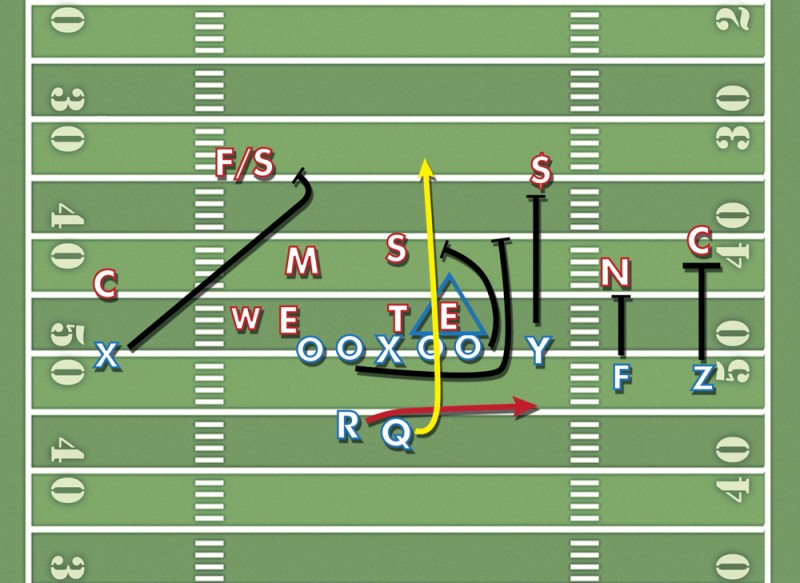Head coach David Shaw and company silenced the critics by calling an excellent game; while Stanford’s yards per play was really nothing to write home about, its outrageous consistency – 3 yards and a cloud of dust – more than made up the difference. Everything flowed from Stanford’s continual victories on the line of scrimmage. The fact of the matter is that Oregon’s defense is significantly undersized: Against Stanford, the starting Duck front seven weighed 1,781 pounds across the board – whereas a more optimal number would be 1,850 pounds – and Stanford’s front seven weighed in at 1,878 pounds.
Stanford’s big offensive line pushed Oregon around all game. The Ducks had no choice but to gamble for sacks and tackles for loss. Desperately trying to penetrate into the backfield, defensive coordinator Nick Aliotti fielded various exotic defensive alignments that football teams rarely see. Aliotti, typically very good at in-game adjustments, came up empty on Thursday – Oregon didn’t sack Kevin Hogan all night, hit him only once, and recorded just three tackles for loss. But even worse, Oregon’s defensive alignments often left the Ducks vulnerable to the Stanford power-running game. Kevin Hogan burned one such defensive front on his 11-yard touchdown run in the second quarter.
Here, Oregon lined up six defenders in the box against six potential Stanford blockers. That’s fine, but notice where the players were positioned. Three Ducks (M, W, and E) were lined up against Stanford left tackle Andrus Peat. Meanwhile, Oregon’s strong side defensive end (E in blue triangle) was lined up inside right tackle Cameron Fleming, which would make it child’s play for Fleming to seal him to the inside on an outside run, and the Ducks had nobody to pressure tight end Charlie Hopkins (Y) on the line of scrimmage in case Hopkins were to block in the run game. Oregon was gambling everything on being able to blow by Peat and tackle running back Ricky Seale in the backfield.
Shaw knew that if he could trust Peat to hold the line for just one second, the question would be not what Stanford could do in the run game, but what it couldn’t do. Here he went for the jugular. Shaw called a read-option play, and that phrase certainly has shades of Oregon football to it, but Stanford’s read option here was not like the Oregon read option.
What Stanford ran was actually an extension of Stanford’s bread-and-butter play, 97 Power, where Yankey pulls right and lead blocks for the tailback. Stanford optioned the strong side defensive end (blue triangle): if the end sat back and waited for a direct run, Hogan (Q) would hand the ball off to Seale (R), while if the end tried to penetrate and attack the handoff, Hogan would punish his aggressiveness by running the ball himself on Power. There are various names for this play – Veer Power and Inverted Veer for example – but I prefer the most obvious: the Power Read.
As it turned out, Peat survived on the backside, Oregon tried to penetrate on the strong side and Hogan took off. Now that he no longer had to block the defensive end, Cameron Fleming hit the second level of the defense immediately and crushed Oregon’s strong side linebacker (S). After Hopkins attacked the strong safety ($) and receiver Devon Cajuste blocked the free safety (F/S), Yankey was free to crush anything in his path, and Hogan could waltz into the end zone.
Stanford’s blocking actually wasn’t very good on this play. You could even say that it was terrible. Yankey and especially Hopkins and Cajuste all failed to control their defenders. But Fleming decisively neutralized the key threat, and with numbers still on his side, Hogan scored a touchdown that signaled to the world that Stanford’s offense had come to play.
As remarkable as Stanford going 10 for 12 on third- and fourth-and-short was the fact that it even had 12 such chances at all. Stanford’s offensive line dominated and constantly put the offense in position to succeed on third down. Nick Aliotti’s defensive alignments certainly helped, but Aliotti would not have had to try these tactics if Oregon’s attempts at conventional defense hadn’t been overwhelmed time and time again. Oregon’s defense on this play was a cry of the damned, and Stanford was its Grim Reaper.
Contact Winston Shi at wshi94 ‘at’ stanford.edu.

